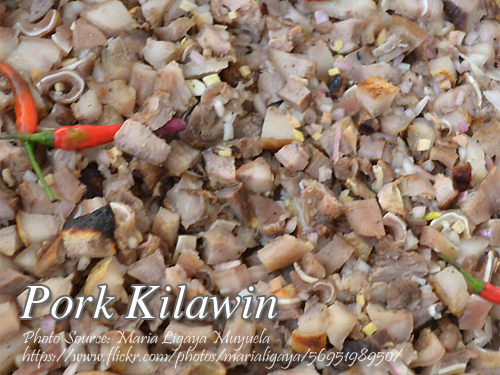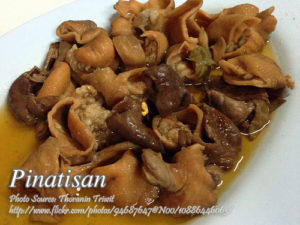A Filipino recipe pork kilawin that consist of pork head meat (remove the bones from the meat and skin) and skin, intestines, pork brain, liver and pork tongue. Kilawin or “ceviche” specially in fish is prepared without cooking and only the vinegar or lime juice will pickle the fish meat. But since pork most of the time is infested with parasites, is should be well cooked. But the way it is prepared is similar to ceviche using pork innards.
A Traditional Dish with a Twist
Growing up in the Philippines, there are few dishes that bring as much nostalgia to me as this unique pork delicacy. It’s a dish that my grandpa used to prepare, especially during special gatherings or fiesta celebrations, when family and friends would come together for an afternoon of laughter, stories, and delicious food. This version of the beloved kilawin holds a special place in my heart, as it not only reminds me of home but also of the warmth that Filipino cuisine brings to the table.
The Kilawin Tradition: From Fish to Pork
Kilawin, a Filipino version of ceviche, is typically associated with fresh fish or seafood marinated in vinegar or citrus juice, allowing the acidity to “cook” the raw meat. But as you might know, kilawin doesn’t stop at seafood. Over the years, different regions and family recipes have incorporated other proteins, particularly pork, into the kilawin family. While raw fish kilawin is common in coastal areas, the pork variant comes from places where meat takes center stage, offering a heartier alternative.
Pork, unlike fish, requires a more thorough cooking process. The acidity from the vinegar is essential in enhancing the flavor, but the meat itself, especially the innards, must be properly cooked due to food safety concerns. Despite this difference, the essence of the dish remains the same—a balance of sour, savory, and spicy elements that awaken the palate.
A Nod to the Past: Ingredients Rooted in Tradition
I can still remember my grandma meticulously preparing the pork parts for this dish, a process that requires patience but yields mouthwatering results. This dish makes use of a variety of pork parts—head meat, intestines, liver, and even the brain. These are ingredients that may seem unfamiliar to some, but for many Filipinos, they are part of a long-standing tradition of making use of the whole animal, a practice that showcases our resourcefulness and respect for the ingredients we have.
The pork head, tongue, intestines, and liver are boiled until tender, then sliced into thin strips. Growing up, I always found it fascinating how my uncle would tell me that boiling the meat right was the key to achieving the perfect texture—tender, yet still with a slight bite. The brain, on the other hand, is boiled separately in vinegar and salt. This might sound unusual to the uninitiated, but it gives the dish an incredibly creamy texture, a rich contrast to the other meaty components.
Cooking Tips Passed Down from Family
As a kid, I used to sit by the kitchen, watching my uncle as he prepared this pork dish. He always had a few tricks up his sleeve, and I’ve carried his advice with me ever since. One tip he always swore by was making sure to simmer the pork parts slowly over low heat. According to him, rushing the cooking process would result in tough meat, and that was something no one wanted. I’ve found this advice especially useful whenever I make this dish, as the key to perfecting it is in the simmering, allowing the flavors to meld together while ensuring each part is tender.
Once all the pork parts are cooked, they are combined with garlic and onions. The final seasoning is a simple but effective mix of salt and pepper. This minimal seasoning allows the flavor of the vinegar and the meat to shine through without overpowering the dish. The simplicity of this recipe is what makes it so special. It’s about letting the quality of the ingredients do the talking.
A Dish That Brings People Together
For me, this pork delicacy is more than just a meal—it’s a reminder of family, culture, and home. The communal aspect of Filipino cuisine is strongly felt when making dishes like this. Every time I prepare it, I’m reminded of how food in the Philippines isn’t just sustenance; it’s a way of bringing people together. Back in the day, when my family would gather around the table to enjoy a big serving of this dish, there was always an air of celebration.
The Evolution of Kilawin
While traditional kilawin with fish remains a favorite, this pork-based version has evolved over time to become a symbol of how adaptable Filipino cuisine is. Even though it started as a way of preparing raw meat, it has transformed into a cooked dish that still holds the essence of kilawin—bright, tangy flavors mixed with savory goodness. It’s a great example of how our culinary traditions change, yet stay rooted in the flavors and techniques of the past.
Embracing the Uniqueness of Pork Kilawin
If you’ve never tried this variation, I encourage you to give it a shot. The combination of flavors and textures—from the slight chew of the pork head meat to the creamy richness of the brain—creates an unforgettable experience. The dish has layers of complexity, but it’s surprisingly easy to prepare, making it perfect for beginner cooks wanting to explore authentic Filipino cuisine.
Remember, the key is in the patience of cooking and the balance of flavors. Just like my grandma used to say, good food takes time, but the joy it brings is well worth the effort. Whether you’re preparing this for a special occasion or simply as a way to connect with Filipino roots, this pork-based kilawin will surely bring a taste of tradition and a burst of flavor to your table.
How to Cook Pork Kilawin
Ingredients
- 1 kilo pork head meat
- 1 pc pork tongue blanched and cleaned
- 150 g small intestine
- 1/4 kg pork liver
- 2 pairs pig's brain
- 1 cup vinegar
- 1 pc onion chopped
- 1 head garlic crushed
- 1 to 2 Tbsp. fine salt
- 1/2 Tbsp. black pepper ground
Instructions
How to cook pork kilawin:
- In a saucepan, put pork head, tongue, small intestines and liver to boil.
- Lower heat and simmer until tender.
- Cut into strips. Set aside. Clean brain and boil in vinegar and salt.
- Combine with the other meats, garlic and onion.
- Season with salt and pepper. Serves 12.
Notes
Cooking Tips:
Simmer Low and Slow for Tender Meat
To ensure the pork head, tongue, intestines, and liver are tender, always simmer them over low heat rather than boiling rapidly. This allows the meat to cook evenly and absorb the flavors without becoming tough. Patience is key—rushing the process will result in a chewy, less enjoyable texture.Balance the Vinegar for the Perfect Tang
When using vinegar, be mindful of the balance between sour and savory. Adding it too early or too much can overpower the dish, so start with a little and adjust to taste after combining the meat. The acidity should enhance, not overwhelm, the natural flavors of the pork and seasonings.Prepare the Brain Separately for Creamy Texture
Boil the pork brain separately in vinegar and salt to achieve the smooth, creamy consistency it adds to the dish. Cooking it on its own prevents it from breaking apart too early and ensures the proper texture. When added at the right time, it creates a rich contrast to the other meats.





